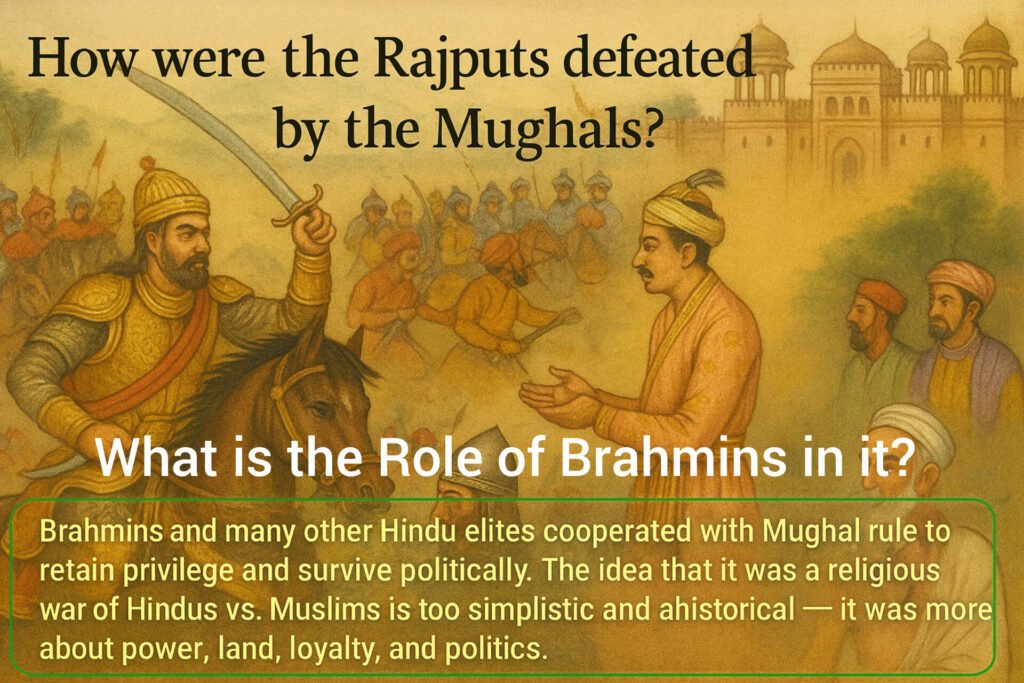🏹 How Were the Rajputs Defeated by the Mughals?
The Rajputs, known for their valor and warrior ethos, were a powerful group of clans primarily based in present-day Rajasthan and surrounding regions of North India. Their interactions with the Mughals stretched across nearly two centuries — beginning with Babur’s invasion in 1526 and escalating during the reign of Akbar (1556–1605).
Despite their reputation for bravery, the Rajputs eventually succumbed to Mughal dominance. Here’s why:
—
🔻 Key Reasons for Their Defeat:
1. Lack of Unity Among Rajputs
Internal rivalries between Rajput clans weakened any chance of a unified resistance. Instead of forming a collective defense, many Rajput rulers prioritized their own power struggles.
2. Superior Mughal Strategy and Army
The Mughals employed advanced artillery, foreign-trained cavalry, and a centralized military command. The Rajputs, although brave, were not militarily modernized to match this level of organization.
3. Diplomatic Absorption
Akbar was not just a conqueror — he was a strategist. He offered marriage alliances, high-ranking positions, and royal favors to many Rajput rulers. Notably, Raja Man Singh of Amber became a trusted general in Akbar’s court. Many Rajputs willingly became part of the Mughal system.
4. Brutal Suppression of Resistance
Rajput leaders who refused to comply — like Maharana Pratap — were met with overwhelming force. Despite their resistance, limited resources and isolation made it impossible to win prolonged wars.
—
📜 What Was the Role of Brahmins and Other Hindus?
✅ Hindus Under Mughal Rule
Contrary to the oversimplified narrative of a Hindu-Muslim war, the Mughal Empire saw significant Hindu participation:
Many Hindus, including Brahmins and Rajputs, served in high-ranking administrative and military roles.
Akbar appointed Tansen (a Brahmin) as a court musician and Raja Todar Mal (a Kayastha) as his finance minister.
Numerous Rajput rulers became Mughal nobles, integrating into the imperial court either by consent or political necessity.
❌ No Large-Scale Brahmin-Led Resistance
Brahmins were largely non-militaristic during this period.
Their roles were mainly ritualistic, scholarly, and administrative.
There is no significant historical record of any large-scale Brahmin resistance against the Mughal Empire.
🧩 Conclusion
The defeat of the Rajputs wasn’t purely due to military might — it was a combination of Mughal strategy, diplomacy, internal Rajput divisions, and co-optation of Hindu elites.
Brahmins and many other Hindu elites cooperated with Mughal rule to retain their privileges and survive politically.
👉🏾 The idea that this was a simple religious war between Hindus and Muslims is historically inaccurate.
It was, in reality, a complex conflict about power, land, loyalty, and political survival — not just religion.
How the Rajputs Fell to the Mughals — And the Role of Brahmins & Hindus in That History

Brahmins and many other Hindu elites cooperated with Mughal rule to retain privilege and survive politically. The idea that it was a religious war of Hindus vs. Muslims is too simplistic and ahistorical — it was more about power, land, loyalty, and politics.
0
Spread the love






More Stories
From Pudukkottai to Parliament: M.M. Abdulla’s Voice for the Voiceless
2 Lakh Per Capita — Without Delhi’s Help: Tamil Nadu’s Silent Economic Revolution – Kathir RS
Sivaji came to Tamil Nadu to kill his brother & Loot the wealth of Tamil Nadu?